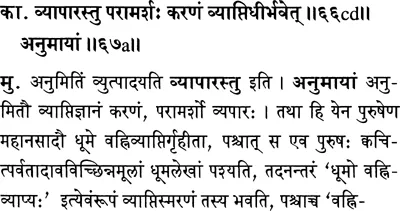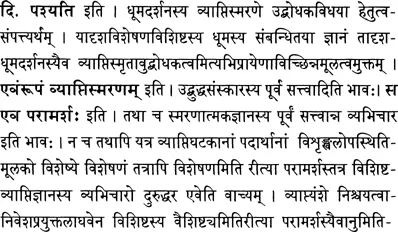![]()
III. Anumānakhaṇḍa Text, Translation and Interpretation
Text 1A
Process of Inferential Knowledge
K. In inferential knowledge consideration is only operation. Instrumental cause is knowledge of invariable concomitance.
(Kārikā 66cd, 67a)
M. (The author) explains inferential knowledge, (with the words) operation (vyāpārastu iti). (The word) anumāyām means: for inferential knowledge (anumāyām anumitau). (For inferential knowledge) knowledge of invariable concomitance is the instrumental cause. Consideration is the operation. As for instance, a man who has cognized the invariable concomitance of fire in smoke in a kitchen etc. later that very same person sees a trail of smoke which is not cut off from its origin on a hill and so on. Afterwards he remembers the invariable concomitance in the form that smoke is invariably connected with fire. Then he knows that this (hill).
M. has smoke which is invariably connected with fire. This knowledge is called consideration (parāmarśa). Afterwards there arises the inferential knowledge ‘the hill has fire’.
D. Inferential knowledge (anumititim iti). Relevance is to be understood here as the relationship of cause and effect between perception (and inference). Only after the instrumental cause is specified there would arise the desire to know what the operation is. Therefore (by the words) knowledge of invariable concomitance (vyāptijñānam iti), (the author) mentions first the instrumental cause which is pointed out afterwards in the basic text. Consideration is operation (parāmarśo vyāpāraḥ iti). Now, however, being an operation means while being produced by something, being the cause of that which is produced by it. This is not the case with regard to consideration, because consideration in the form ‘this mountain has smoke which is invariably connected with fire’ is not produced by the knowledge of invariable concomitance since at that time there is no knowledge of the invariable concomitance of fire in the kitchen and therefore there is deviation. Hence this (i.e. the fact of being produced by knowledge of invariable concomitance) is now explained (with the words) as for instance (tathāhi ityā dinā).
D. Sees (paśyati iti). (This is) in order to establish that perception of smoke, in as far as it is a reviver, is the cause of remembering invariable concomitance. Smoke has a particular characteristic, and the perception of the same kind of smoke as having that characteristic is the reminder for the remembrance of invariable concomitance. With this idea in mind, it is mentioned ‘a trail (of smoke) which is not cut off from its origin’. Then he remembers invariable concomitance in the form (evaṃrūpaṃ vyāptismaraṇam iti). The idea is that the impression which is revived was already there. This knowledge is called consideration (sa eva parāmarśaḥ iti). Thus because there is already knowledge in the form of remembrance, there is no deviation. This is the idea. Nor should it be objected that when there is consideration (the objects of which) are various things which are elements of invariable concomitance (and which) are cognized in the form of unconnected instances of knowledge in the manner that there is a qualifier for the qualificand and it has a further qualifier, the deviation of the knowledge of qualified invariable concomitance is indeed unavoidable. This (objection) is rejected because consideration in the form of the cognition of the relationship of that which is qualified is simple since in this case there is no need of adding ‘being certain’ in the enunciation of the invariable concomitance and therefore, only such consideration
D. is accepted as the cause of inference. Nor can it again be objected that there is deviation if consideration is in the form of remembrance because by the relationship of impression there exists already the knowledge of invariable concomitance.
On this point (the opinion of) the moderns is the following: the state of being knowledge of invariable concomitance pervades the state of being consideration. And therefore, (knowledge of invariable concomitance) is not even the cause of inferential knowledge. Hence how can it be the instrumental cause (of inferential knowledge)? Otherwise the two parts etc. of a pot, in as far as they are substances, would have to be considered as causes of the pot and therefore they hold that the state of being mind is the determinant of the state of being the instrumental cause of inferential knowledge.
Commentary
(p.62, ln 3) After the treatment of perception, when the discussion on inference is introduced, Râmarudra raises the question of Relevance (saṅgati). In itself the notion of Relevance is simple; it is the question why one topic is to be discussed after another or what is the connection of what is going to be treated with what has been already treated? This is also an appropriate place to tackle this question since perception has been adequately dealt with and the next topic to be taken up is inference. Hence naturally the question arises, what is the connection of inference with perception, or in technical Nyāya terms what is the Relevance (saṅgati) in treating inference? Dinakara states that there is the relationship of cause and effect between perception and inference. Rāmarudra explains this, pointing out first of all the real nature of Relevance; he then enumerates the kinds of Relevance and describes in detail the true characteristics of each one. We shall take up these questions one by one.
Rāmarudra defines Relevance in the following words: anantarābhidhānaprayojakajijñāsājanakajñānaviṣayasmaraṇānukūlasaṃbandho nirūpaṇīyaniṣṭhā saṅgatiḥ. This may be translated as follows: Relevance that is in the subject to be treated is a relation which is conducive to the remembrance of the object of a particular instance of knowledge which is the cause of the desire to know. This desire to know causes the treatment (of a topic) after (the previous topic has been treated). Now let us analyse this definition and bring out its meaning part by part.
Basic to the whole definition of saṅgati is that it is a kind of relation (saṃbandha This relation is conducive to the remembrance of the object of a particular instance of cognition. This particular instance of cognition is the cause of producing the desire to know (jijñāsā) and this desire in its turn is the reason why a certain topic is treated after another topic. Applying all this to the present case, viz. the treatment of inference after perception, we get the following picture of the causal relationship that is envisaged.
The desire to know which is the cause of treating inference after perception has the following form: ‘let me have the knowledge of inference (anumānajñānaṃ me bhavatu)’. The knowledge which produces this desire to know is in the following form: ‘the knowledge of inference produces what is desirable for me (anumānajñānaṃ madiṣṭtasādhanamy)’. The object of such a knowledge is inference; the relation which is conducive to remember inference is the fact that it is produced by perception.
In simpler language this just means that after perception has been treated, a person remembers inference because it is produced by perception and so he thinks that knowledge of inference is a means of obtaining what is desirable for him. Therefore he has the desire to know about inference. This desire to know (on the part of the pupil) is the reason why inference is treated (by the teacher).
Therefore the succession of events in the order of time is the following: knowledge of perception (pratyakṣajñāna), remembrance of inference (anumānasmaraṇa) because it is an effect of perception, knowledge that the knowledge of inference is the means of fulfilling one's desire (iṣṍasādhanatājñāna) and therefore finally the desire to know inference (jijñāsā). Then the treatment of inference follows.
Now by means of a series of objections and answers Râmarudra elucidates the real meaning of this definition of Relevance. First of all it should be noted that the knowledge which is the cause of the desire to know (i.e. anumānajñānaṃ madiṣṭasādhanam) which in turn is the reason that a particular topic is treated after another topic, should be qualified by being produced by the knowledge that indicates Relevance. This just means that the knowledge anumānajñānam madiṣṭasādhanam should be brought about by pratyakṣajñāna. The need for this stipulation is the following: one treats about jar and after this has been treated one remembers perception by means of some particular relation, as for instance, jar is the object of perception. And perception produces inference. Therefore, after the treatment of a jar one can treat inference; but in this case there will not be any Relevance since knowledge of inference is not brought about by knowledge of jar. But if as in the present instance, inference is treated after perception, there is Relevance. This is because, the knowledge of invariable concomitance (i.e. vyāptijñāna = anumāna) is perceptual and so it is brought about by means of the eyes and so on. Similarly inferential knowledge is produced by perceptual knowledge in the form of consideration (parāmarśa). Therefore there is Relevance in the form of upajḫva-katva in treating inferential knowledge after perceptual knowledge.
But then there could be the following objection: according to the Vedic belief, offering a light to a particular god in a particular temple is good for the eye. This offering of light is done through an inference, viz. the offering of light is indeed a means of obtaining eyes because it has been enjoined by the Vedas that offering of light is good for eyes. After such an inference one offers light and one gets the eyes which are the instrument of perception. Hence since perception (i.e. instrument of perception) is brought about by inference, inference is to be treated first and then perception. This is the objection.
Someone may answer this objection in the following way: Relevance in the form of being an effect (upajīvakatva) should be in the form of an immediate effect (kāryatārūpa) and not in the form of a...




